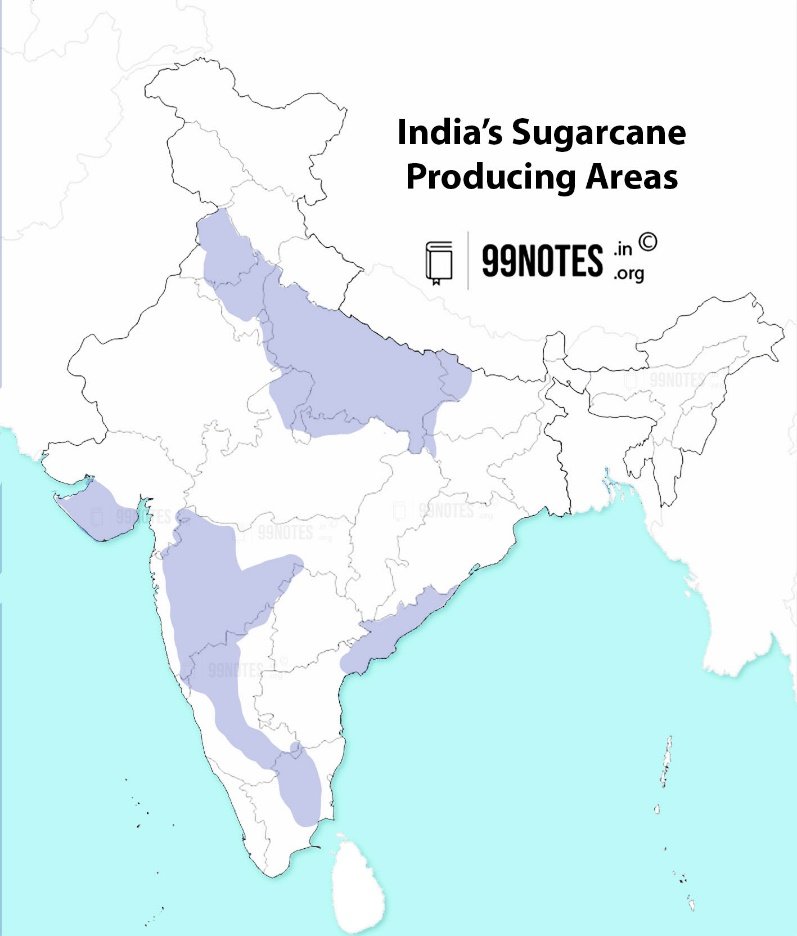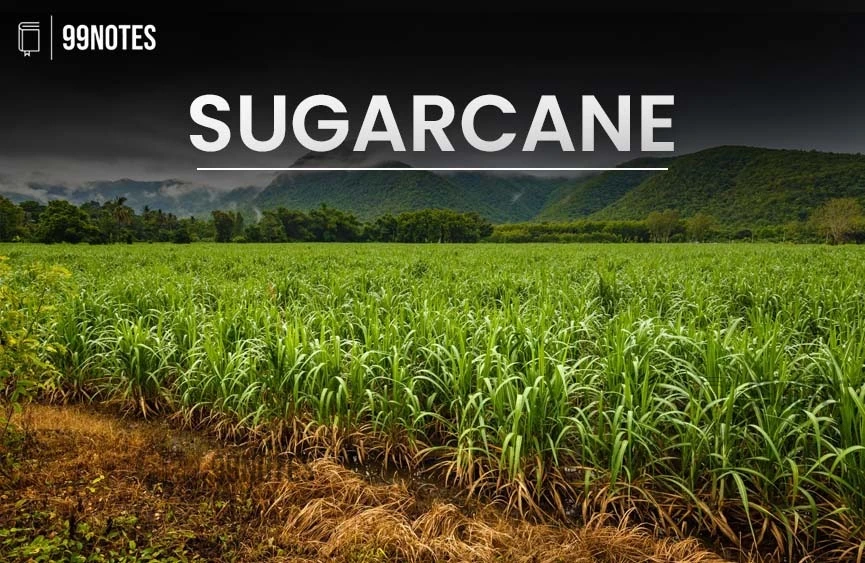Sugarcane
Sugarcane is classified as a long-duration crop with a period of 10 to 15 months. Many varieties take as long as 18 months. Around 2.4% of India’s area remains under sugarcane production and by weight around 2% of India’s total agricultural produce.
Agro-Climatic Condition for Sugarcane:
Sugarcane requires the following climatic and soil conditions.
- Climate: Tropical and subtropical climates are ideal for sugarcane. It requires a long, warm growing season with well-distributed rainfall, although irrigation is often necessary during dry periods.
- Soil: Well-drained, deep loamy or sandy soils rich in organic matter are best suited for sugarcane farming. The crop prefers soils with good moisture retention capacity.
- Temperature: Sugarcane thrives in temperatures ranging from 20°C to 30°C, with high humidity.
- Water: Sugarcane is a water-intensive crop, especially in areas without sufficient rainfall. It may require 150 to 200 cm of water through rainfall or irrigation depending on its variety.
|
Crop |
Conditions | States in India |
India’s Position |
| Sugarcane:
Source of Sugar, Gur (jaggary), Khandsari and molasses. |
|
2.4% area
|
Top Producers: Brazil, India.
|
Uses of Sugarcane
- In India sugarcane is grown for the production of sugar, jaggery (gur), Khandsari and molasses.
- Sugarcane is the main source for the production of bio-ethanol, which is used for Ethanol blending of petrol in India.
- Bagasse, which is the fibrous residue left after extracting juice, is used as a fuel for power generation and as raw material for paper production.
| Sugarcane is indigenous to India. The term Sugar itself comes from the Sanskrit term ‘śarkarā’. Sugar was first in its crystal form in India (Khand). This technology of refining and crystallising sugar was spread throughout the world from India. Before this, honey was often used as a sweetener. |
Geographical extent of Sugar Production:
The Sugarcane Production is associated with two main regions of India: 
North India:
- Uttar Pradesh: The largest sugarcane-producing state in India, contributing to nearly 40% of the total national sugar production.
- Haryana and Punjab.
- Bihar, Gujarat, and Rajasthan: Other states where sugarcane is cultivated, although to a lesser extent.
South India
- Maharashtra: A major producer of sugarcane, especially in areas like Pune, Kolhapur, and Sangli, despite being a water-deficit region.
- Karnataka: Known for high-yielding sugarcane varieties. For example, Mandya district.
- Tamil Nadu: Another significant producer, especially in the southern region.
- Andhra Pradesh: The Krishna-Godavari delta region of Andhra Pradesh.
Problem of Sugarcane Production in India:
UP and Bihar were top sugar-producing states once upon a time. However, they have lost their position in states such as Maharashtra and Tamil Nadu.
The sugar industry of India is gradually shifting from north India to peninsular India because of:
- The tropical climate of Peninsular India results in higher yield per unit hectare of land.
- Higher sucrose content in peninsular cane which is a longer duration crop (generally 16-18 months)
- Long crushing season in the south: In North India, it lasts from November to February (4 months); while in the South it lasts from October to May or even June (nearly 8 months) since the south grows a longer duration variety that is harvested in the winters.
Challenges Faced by Sugarcane Farmers
- Water Scarcity: Sugar takes 2000 litres for 1 kg of sugar production. Many of the major growing regions in India (especially in Peninsular India) are facing water shortages, making large-scale sugarcane farming unsustainable in the long run.
We incentivise Sugar production using high FRP (Fixed remunerative Price), over which state governments often add their own subsidy. This production is either utilised for sugar production or ethanol production. However, there still is an excess production which is exported. This means that we are practically exporting water.
- Price Fluctuations: Sugarcane prices can be volatile, which affects the income of farmers. The price of sugar is often influenced by global market conditions, government policies, and domestic demand.
- Labour Shortage: Manual labour is required for planting, maintaining, and harvesting sugarcane. There is often a shortage of labour, particularly during peak harvest seasons, leading to higher costs and reduced productivity.
- Climate Change: Variations in rainfall, temperature extremes, and changes in weather patterns can impact crop yields and quality. Farmers face the risk of droughts and floods, which can affect both the production and the timing of harvesting.
Pests and Diseases: Pests and diseases such as whiteflies, sugarcane borer, and red rot can damage the crop and reduce yields. Effective pest management practices are crucial, but pesticide misuse and resistance can complicate control efforts.







![Post Mauryan Period: Shunga, Kanva Dynasties &Amp; More [Upsc Notes] | Updated April 16, 2025 Post Mauryan Period: Shunga, Kanva Dynasties & More [Upsc Notes]](https://www.99notes.in/wp-content/uploads/2023/04/post-mauryan-age-99notes-upsc-1-768x495.webp)